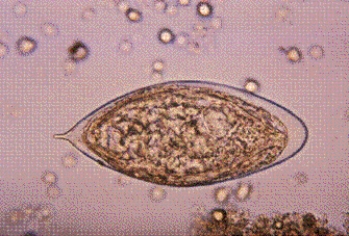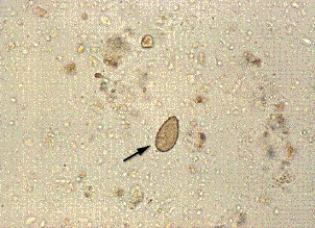Course
Microbiology
Study Pack
Set 28 Diagnostic Parasitology
Question 1
(Multiple Choice)
Free
A young man who returned a week ago from a family vacation to Kenya develops a high fever and delirium. Although he was compliant with his antimalarial medications, a blood sample is taken to rule out malaria. The laboratory scientist sees the following on the blood smear at 1000 × . This organism is most likely  × . This organism is most likely A) Trypanosoma brucei. B) Leishmania donovani. C) Wuchereria bancrofti. D) Loa loa." class="answers-bank-image d-block" loading="lazy" >
× . This organism is most likely A) Trypanosoma brucei. B) Leishmania donovani. C) Wuchereria bancrofti. D) Loa loa." class="answers-bank-image d-block" loading="lazy" >
 × . This organism is most likely A) Trypanosoma brucei. B) Leishmania donovani. C) Wuchereria bancrofti. D) Loa loa." class="answers-bank-image d-block" loading="lazy" >
× . This organism is most likely A) Trypanosoma brucei. B) Leishmania donovani. C) Wuchereria bancrofti. D) Loa loa." class="answers-bank-image d-block" loading="lazy" >A) Trypanosoma brucei.
B) Leishmania donovani.
C) Wuchereria bancrofti.
D) Loa loa.
Answer
Question 2
(Multiple Choice)
Free
An international male student from Egypt comes to the campus clinic complaining of blood in his urine. A urinalysis reveals the parasite seen below at 400 × . This organism is  × . This organism is A) Schistosoma mansoni. B) S. japonicum. C) S. haematobium. D) S. madurella." class="answers-bank-image d-block" loading="lazy" >
× . This organism is A) Schistosoma mansoni. B) S. japonicum. C) S. haematobium. D) S. madurella." class="answers-bank-image d-block" loading="lazy" >
 × . This organism is A) Schistosoma mansoni. B) S. japonicum. C) S. haematobium. D) S. madurella." class="answers-bank-image d-block" loading="lazy" >
× . This organism is A) Schistosoma mansoni. B) S. japonicum. C) S. haematobium. D) S. madurella." class="answers-bank-image d-block" loading="lazy" >A) Schistosoma mansoni.
B) S. japonicum.
C) S. haematobium.
D) S. madurella.
Answer
Question 3
(Multiple Choice)
Free
A woman who just returned from a trip to Southeast Asia has signs of biliary obstruction, which is confirmed by CT scan. Due to her recent travel history, the physician orders an ova and parasites examination before considering surgical intervention. The following element is found in her fecal sample at 400 × . The most likely identity of this organism is  × . The most likely identity of this organism is A) Schistosoma mansoni. B) Clonorchis sinensis. C) Fasciola hepatica. D) Heterophyes heterophyes." class="answers-bank-image d-block" loading="lazy" >
× . The most likely identity of this organism is A) Schistosoma mansoni. B) Clonorchis sinensis. C) Fasciola hepatica. D) Heterophyes heterophyes." class="answers-bank-image d-block" loading="lazy" >
 × . The most likely identity of this organism is A) Schistosoma mansoni. B) Clonorchis sinensis. C) Fasciola hepatica. D) Heterophyes heterophyes." class="answers-bank-image d-block" loading="lazy" >
× . The most likely identity of this organism is A) Schistosoma mansoni. B) Clonorchis sinensis. C) Fasciola hepatica. D) Heterophyes heterophyes." class="answers-bank-image d-block" loading="lazy" >A) Schistosoma mansoni.
B) Clonorchis sinensis.
C) Fasciola hepatica.
D) Heterophyes heterophyes.
Answer